Principles and Applications of Macroeconomics: UK Economic Analysis
VerifiedAdded on 2023/06/12
|13
|3708
|177
Essay
AI Summary
This essay delves into the principles and applications of macroeconomics, focusing on key concepts such as GDP, monetary policy, and fiscal policy. It examines how governments use these policies to stabilize economies, manage inflation, and promote economic growth. The essay also provides a detailed analysis of UK economic policy from 1980 to the present day, covering themes such as economic output, trade, interest rates, and public sector debt. It further discusses the role of the Bank of England in managing inflation and the impact of fiscal rules on government spending and taxation. The essay references expansionary and contractionary policies and their effects on the UK economy. Desklib provides access to similar solved assignments and study resources for students.
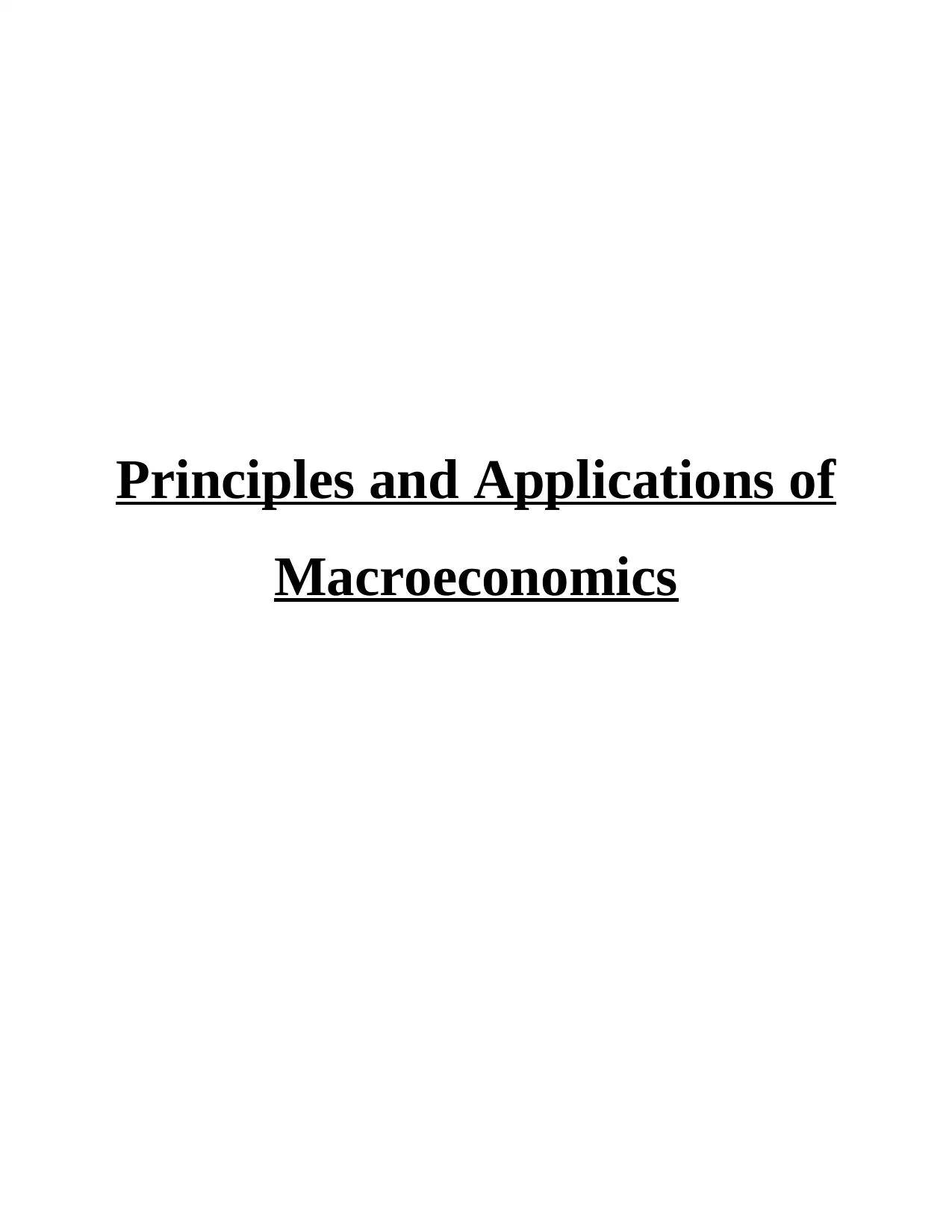
Principles and Applications of
Macroeconomics
Macroeconomics
Paraphrase This Document
Need a fresh take? Get an instant paraphrase of this document with our AI Paraphraser

TABLE OF CONTENTS
TOPIC 1...........................................................................................................................................3
ESSAY.............................................................................................................................................3
REFERENCES..............................................................................................................................12
TOPIC 1...........................................................................................................................................3
ESSAY.............................................................................................................................................3
REFERENCES..............................................................................................................................12
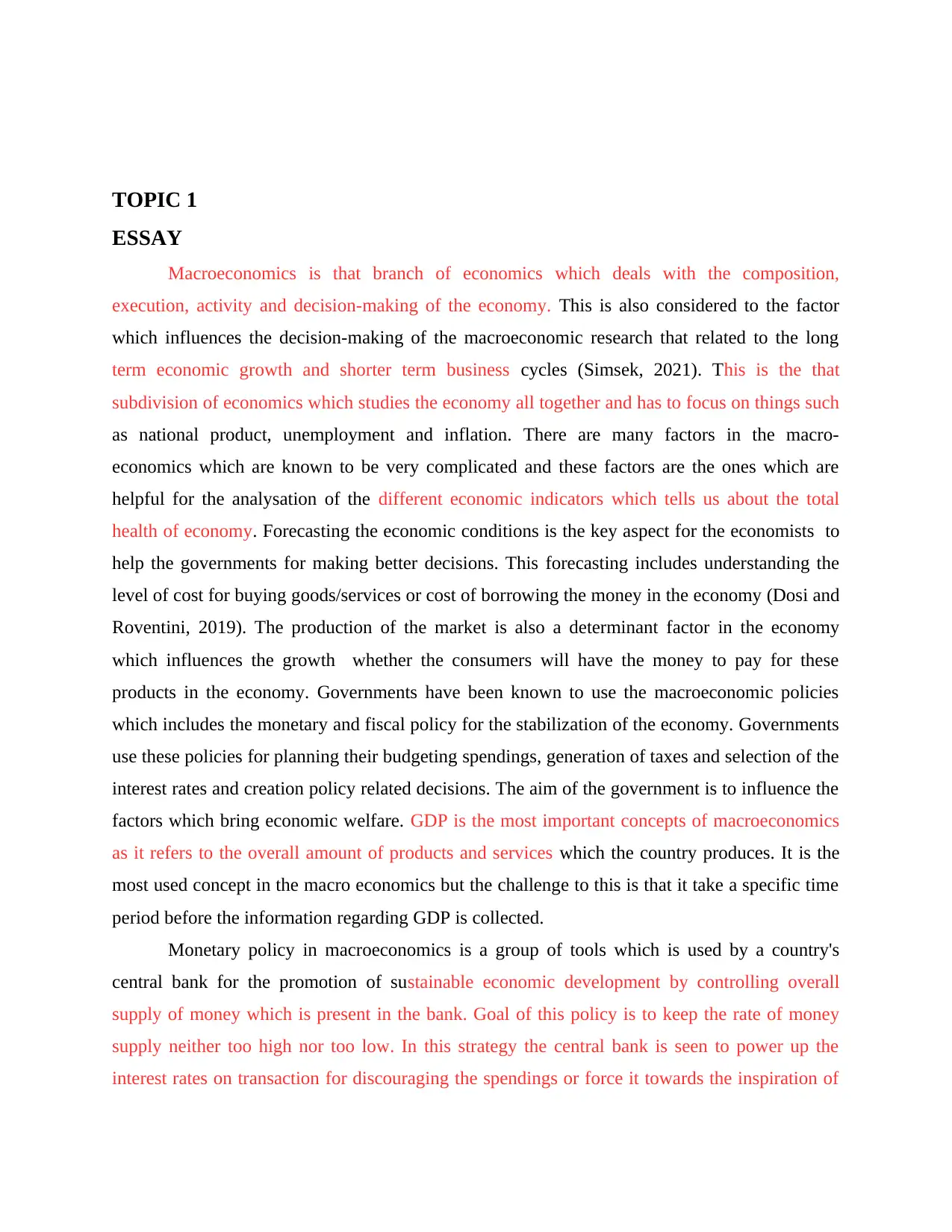
TOPIC 1
ESSAY
Macroeconomics is that branch of economics which deals with the composition,
execution, activity and decision-making of the economy. This is also considered to the factor
which influences the decision-making of the macroeconomic research that related to the long
term economic growth and shorter term business cycles (Simsek, 2021). This is the that
subdivision of economics which studies the economy all together and has to focus on things such
as national product, unemployment and inflation. There are many factors in the macro-
economics which are known to be very complicated and these factors are the ones which are
helpful for the analysation of the different economic indicators which tells us about the total
health of economy. Forecasting the economic conditions is the key aspect for the economists to
help the governments for making better decisions. This forecasting includes understanding the
level of cost for buying goods/services or cost of borrowing the money in the economy (Dosi and
Roventini, 2019). The production of the market is also a determinant factor in the economy
which influences the growth whether the consumers will have the money to pay for these
products in the economy. Governments have been known to use the macroeconomic policies
which includes the monetary and fiscal policy for the stabilization of the economy. Governments
use these policies for planning their budgeting spendings, generation of taxes and selection of the
interest rates and creation policy related decisions. The aim of the government is to influence the
factors which bring economic welfare. GDP is the most important concepts of macroeconomics
as it refers to the overall amount of products and services which the country produces. It is the
most used concept in the macro economics but the challenge to this is that it take a specific time
period before the information regarding GDP is collected.
Monetary policy in macroeconomics is a group of tools which is used by a country's
central bank for the promotion of sustainable economic development by controlling overall
supply of money which is present in the bank. Goal of this policy is to keep the rate of money
supply neither too high nor too low. In this strategy the central bank is seen to power up the
interest rates on transaction for discouraging the spendings or force it towards the inspiration of
ESSAY
Macroeconomics is that branch of economics which deals with the composition,
execution, activity and decision-making of the economy. This is also considered to the factor
which influences the decision-making of the macroeconomic research that related to the long
term economic growth and shorter term business cycles (Simsek, 2021). This is the that
subdivision of economics which studies the economy all together and has to focus on things such
as national product, unemployment and inflation. There are many factors in the macro-
economics which are known to be very complicated and these factors are the ones which are
helpful for the analysation of the different economic indicators which tells us about the total
health of economy. Forecasting the economic conditions is the key aspect for the economists to
help the governments for making better decisions. This forecasting includes understanding the
level of cost for buying goods/services or cost of borrowing the money in the economy (Dosi and
Roventini, 2019). The production of the market is also a determinant factor in the economy
which influences the growth whether the consumers will have the money to pay for these
products in the economy. Governments have been known to use the macroeconomic policies
which includes the monetary and fiscal policy for the stabilization of the economy. Governments
use these policies for planning their budgeting spendings, generation of taxes and selection of the
interest rates and creation policy related decisions. The aim of the government is to influence the
factors which bring economic welfare. GDP is the most important concepts of macroeconomics
as it refers to the overall amount of products and services which the country produces. It is the
most used concept in the macro economics but the challenge to this is that it take a specific time
period before the information regarding GDP is collected.
Monetary policy in macroeconomics is a group of tools which is used by a country's
central bank for the promotion of sustainable economic development by controlling overall
supply of money which is present in the bank. Goal of this policy is to keep the rate of money
supply neither too high nor too low. In this strategy the central bank is seen to power up the
interest rates on transaction for discouraging the spendings or force it towards the inspiration of
⊘ This is a preview!⊘
Do you want full access?
Subscribe today to unlock all pages.

Trusted by 1+ million students worldwide
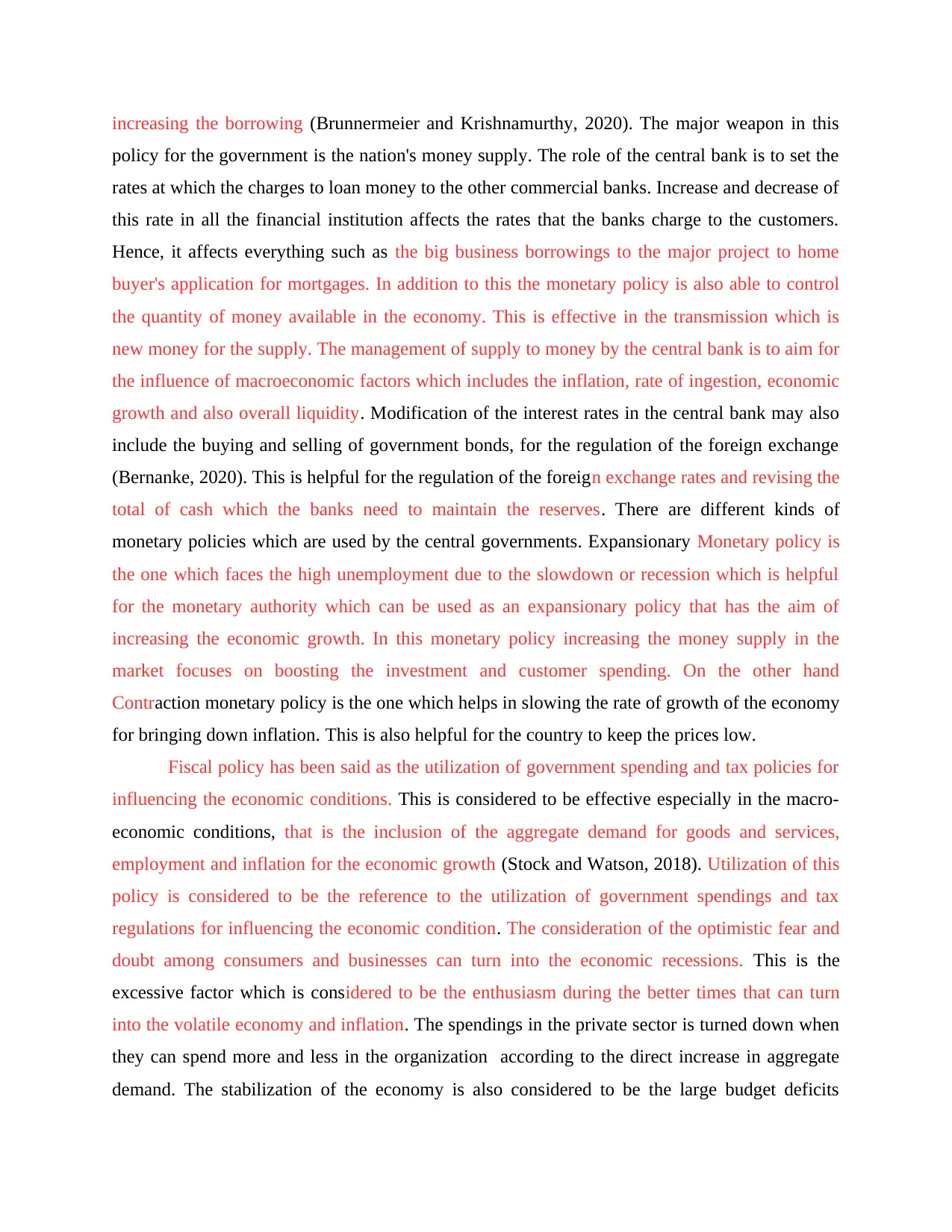
increasing the borrowing (Brunnermeier and Krishnamurthy, 2020). The major weapon in this
policy for the government is the nation's money supply. The role of the central bank is to set the
rates at which the charges to loan money to the other commercial banks. Increase and decrease of
this rate in all the financial institution affects the rates that the banks charge to the customers.
Hence, it affects everything such as the big business borrowings to the major project to home
buyer's application for mortgages. In addition to this the monetary policy is also able to control
the quantity of money available in the economy. This is effective in the transmission which is
new money for the supply. The management of supply to money by the central bank is to aim for
the influence of macroeconomic factors which includes the inflation, rate of ingestion, economic
growth and also overall liquidity. Modification of the interest rates in the central bank may also
include the buying and selling of government bonds, for the regulation of the foreign exchange
(Bernanke, 2020). This is helpful for the regulation of the foreign exchange rates and revising the
total of cash which the banks need to maintain the reserves. There are different kinds of
monetary policies which are used by the central governments. Expansionary Monetary policy is
the one which faces the high unemployment due to the slowdown or recession which is helpful
for the monetary authority which can be used as an expansionary policy that has the aim of
increasing the economic growth. In this monetary policy increasing the money supply in the
market focuses on boosting the investment and customer spending. On the other hand
Contraction monetary policy is the one which helps in slowing the rate of growth of the economy
for bringing down inflation. This is also helpful for the country to keep the prices low.
Fiscal policy has been said as the utilization of government spending and tax policies for
influencing the economic conditions. This is considered to be effective especially in the macro-
economic conditions, that is the inclusion of the aggregate demand for goods and services,
employment and inflation for the economic growth (Stock and Watson, 2018). Utilization of this
policy is considered to be the reference to the utilization of government spendings and tax
regulations for influencing the economic condition. The consideration of the optimistic fear and
doubt among consumers and businesses can turn into the economic recessions. This is the
excessive factor which is considered to be the enthusiasm during the better times that can turn
into the volatile economy and inflation. The spendings in the private sector is turned down when
they can spend more and less in the organization according to the direct increase in aggregate
demand. The stabilization of the economy is also considered to be the large budget deficits
policy for the government is the nation's money supply. The role of the central bank is to set the
rates at which the charges to loan money to the other commercial banks. Increase and decrease of
this rate in all the financial institution affects the rates that the banks charge to the customers.
Hence, it affects everything such as the big business borrowings to the major project to home
buyer's application for mortgages. In addition to this the monetary policy is also able to control
the quantity of money available in the economy. This is effective in the transmission which is
new money for the supply. The management of supply to money by the central bank is to aim for
the influence of macroeconomic factors which includes the inflation, rate of ingestion, economic
growth and also overall liquidity. Modification of the interest rates in the central bank may also
include the buying and selling of government bonds, for the regulation of the foreign exchange
(Bernanke, 2020). This is helpful for the regulation of the foreign exchange rates and revising the
total of cash which the banks need to maintain the reserves. There are different kinds of
monetary policies which are used by the central governments. Expansionary Monetary policy is
the one which faces the high unemployment due to the slowdown or recession which is helpful
for the monetary authority which can be used as an expansionary policy that has the aim of
increasing the economic growth. In this monetary policy increasing the money supply in the
market focuses on boosting the investment and customer spending. On the other hand
Contraction monetary policy is the one which helps in slowing the rate of growth of the economy
for bringing down inflation. This is also helpful for the country to keep the prices low.
Fiscal policy has been said as the utilization of government spending and tax policies for
influencing the economic conditions. This is considered to be effective especially in the macro-
economic conditions, that is the inclusion of the aggregate demand for goods and services,
employment and inflation for the economic growth (Stock and Watson, 2018). Utilization of this
policy is considered to be the reference to the utilization of government spendings and tax
regulations for influencing the economic condition. The consideration of the optimistic fear and
doubt among consumers and businesses can turn into the economic recessions. This is the
excessive factor which is considered to be the enthusiasm during the better times that can turn
into the volatile economy and inflation. The spendings in the private sector is turned down when
they can spend more and less in the organization according to the direct increase in aggregate
demand. The stabilization of the economy is also considered to be the large budget deficits
Paraphrase This Document
Need a fresh take? Get an instant paraphrase of this document with our AI Paraphraser
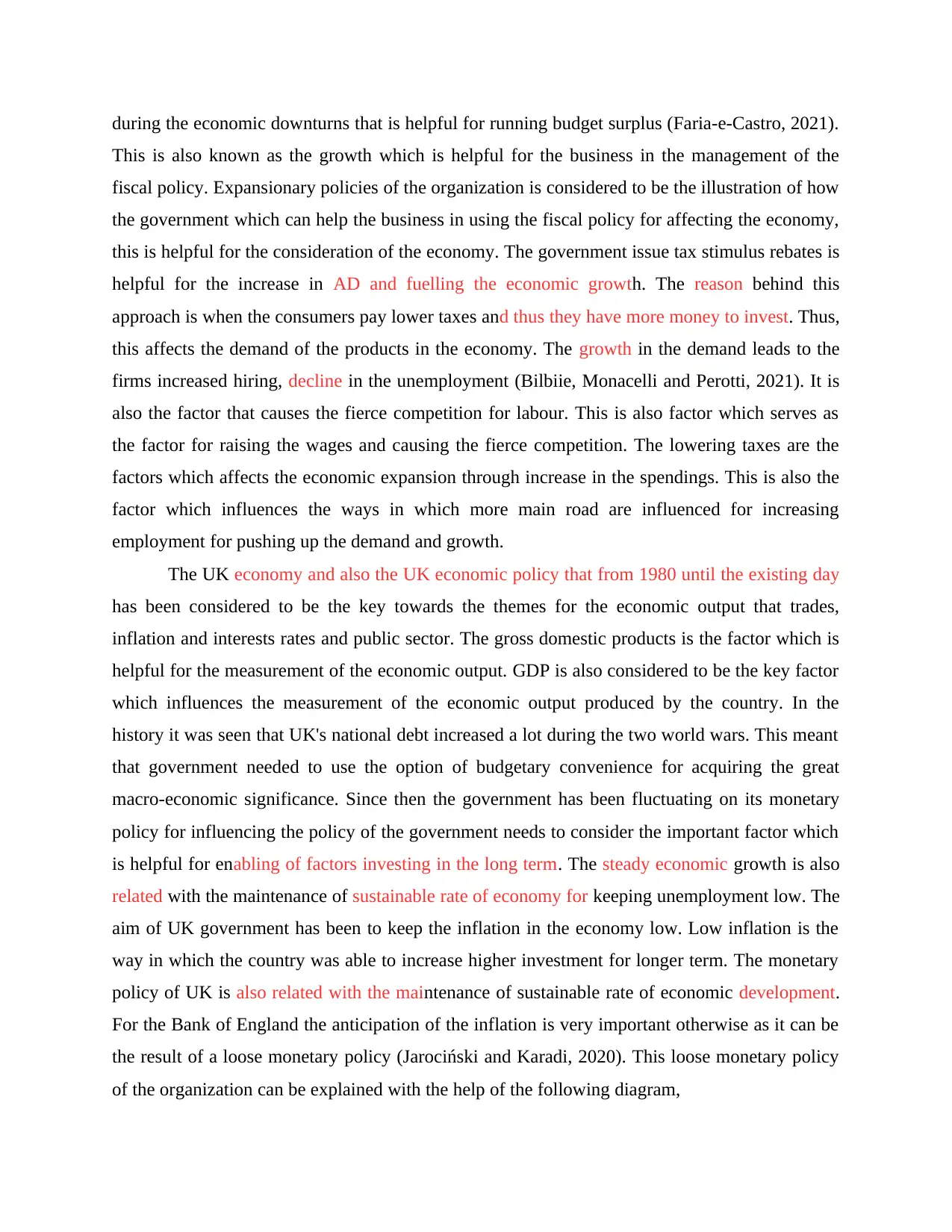
during the economic downturns that is helpful for running budget surplus (Faria-e-Castro, 2021).
This is also known as the growth which is helpful for the business in the management of the
fiscal policy. Expansionary policies of the organization is considered to be the illustration of how
the government which can help the business in using the fiscal policy for affecting the economy,
this is helpful for the consideration of the economy. The government issue tax stimulus rebates is
helpful for the increase in AD and fuelling the economic growth. The reason behind this
approach is when the consumers pay lower taxes and thus they have more money to invest. Thus,
this affects the demand of the products in the economy. The growth in the demand leads to the
firms increased hiring, decline in the unemployment (Bilbiie, Monacelli and Perotti, 2021). It is
also the factor that causes the fierce competition for labour. This is also factor which serves as
the factor for raising the wages and causing the fierce competition. The lowering taxes are the
factors which affects the economic expansion through increase in the spendings. This is also the
factor which influences the ways in which more main road are influenced for increasing
employment for pushing up the demand and growth.
The UK economy and also the UK economic policy that from 1980 until the existing day
has been considered to be the key towards the themes for the economic output that trades,
inflation and interests rates and public sector. The gross domestic products is the factor which is
helpful for the measurement of the economic output. GDP is also considered to be the key factor
which influences the measurement of the economic output produced by the country. In the
history it was seen that UK's national debt increased a lot during the two world wars. This meant
that government needed to use the option of budgetary convenience for acquiring the great
macro-economic significance. Since then the government has been fluctuating on its monetary
policy for influencing the policy of the government needs to consider the important factor which
is helpful for enabling of factors investing in the long term. The steady economic growth is also
related with the maintenance of sustainable rate of economy for keeping unemployment low. The
aim of UK government has been to keep the inflation in the economy low. Low inflation is the
way in which the country was able to increase higher investment for longer term. The monetary
policy of UK is also related with the maintenance of sustainable rate of economic development.
For the Bank of England the anticipation of the inflation is very important otherwise as it can be
the result of a loose monetary policy (Jarociński and Karadi, 2020). This loose monetary policy
of the organization can be explained with the help of the following diagram,
This is also known as the growth which is helpful for the business in the management of the
fiscal policy. Expansionary policies of the organization is considered to be the illustration of how
the government which can help the business in using the fiscal policy for affecting the economy,
this is helpful for the consideration of the economy. The government issue tax stimulus rebates is
helpful for the increase in AD and fuelling the economic growth. The reason behind this
approach is when the consumers pay lower taxes and thus they have more money to invest. Thus,
this affects the demand of the products in the economy. The growth in the demand leads to the
firms increased hiring, decline in the unemployment (Bilbiie, Monacelli and Perotti, 2021). It is
also the factor that causes the fierce competition for labour. This is also factor which serves as
the factor for raising the wages and causing the fierce competition. The lowering taxes are the
factors which affects the economic expansion through increase in the spendings. This is also the
factor which influences the ways in which more main road are influenced for increasing
employment for pushing up the demand and growth.
The UK economy and also the UK economic policy that from 1980 until the existing day
has been considered to be the key towards the themes for the economic output that trades,
inflation and interests rates and public sector. The gross domestic products is the factor which is
helpful for the measurement of the economic output. GDP is also considered to be the key factor
which influences the measurement of the economic output produced by the country. In the
history it was seen that UK's national debt increased a lot during the two world wars. This meant
that government needed to use the option of budgetary convenience for acquiring the great
macro-economic significance. Since then the government has been fluctuating on its monetary
policy for influencing the policy of the government needs to consider the important factor which
is helpful for enabling of factors investing in the long term. The steady economic growth is also
related with the maintenance of sustainable rate of economy for keeping unemployment low. The
aim of UK government has been to keep the inflation in the economy low. Low inflation is the
way in which the country was able to increase higher investment for longer term. The monetary
policy of UK is also related with the maintenance of sustainable rate of economic development.
For the Bank of England the anticipation of the inflation is very important otherwise as it can be
the result of a loose monetary policy (Jarociński and Karadi, 2020). This loose monetary policy
of the organization can be explained with the help of the following diagram,
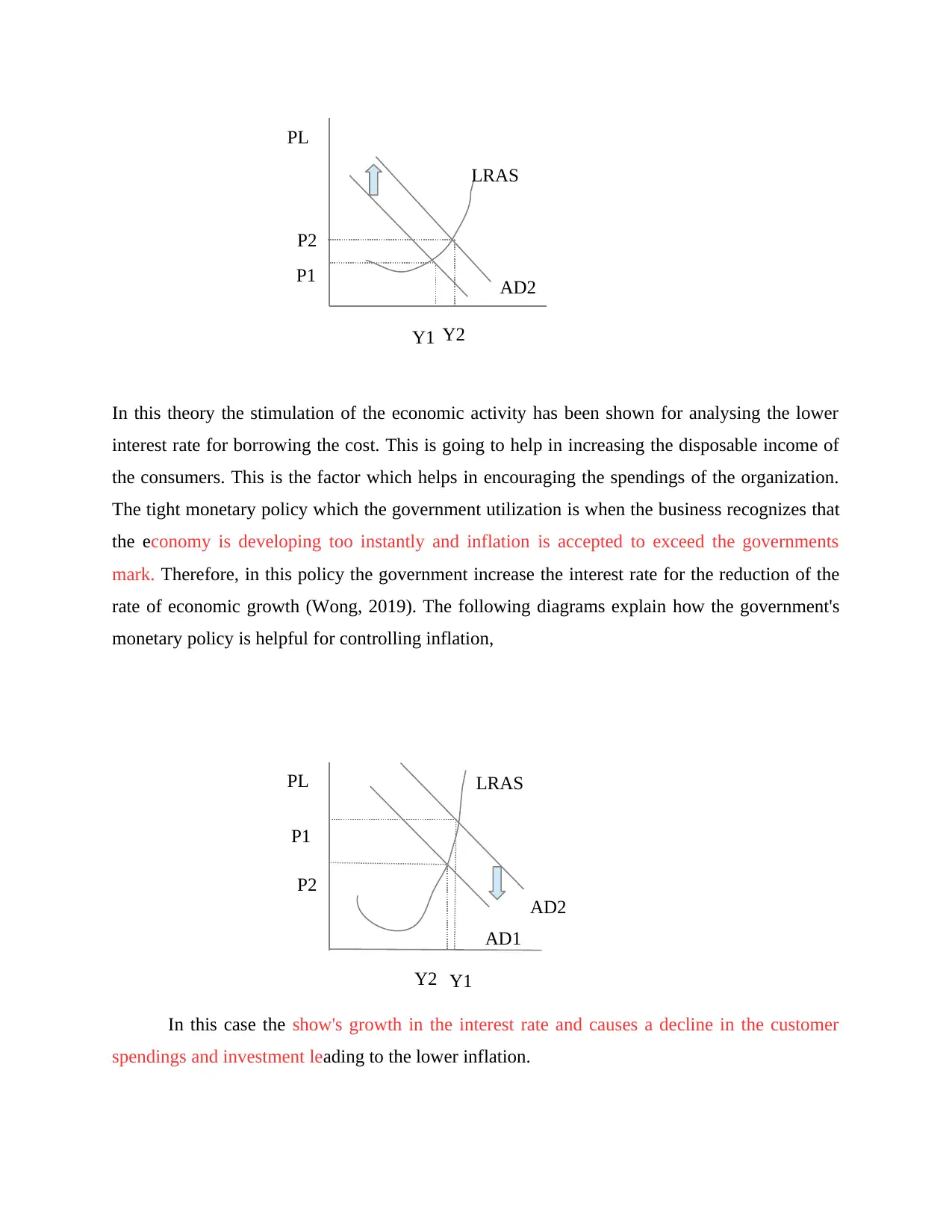
In this theory the stimulation of the economic activity has been shown for analysing the lower
interest rate for borrowing the cost. This is going to help in increasing the disposable income of
the consumers. This is the factor which helps in encouraging the spendings of the organization.
The tight monetary policy which the government utilization is when the business recognizes that
the economy is developing too instantly and inflation is accepted to exceed the governments
mark. Therefore, in this policy the government increase the interest rate for the reduction of the
rate of economic growth (Wong, 2019). The following diagrams explain how the government's
monetary policy is helpful for controlling inflation,
In this case the show's growth in the interest rate and causes a decline in the customer
spendings and investment leading to the lower inflation.
LRAS
PL
P2
P1 AD2
LRASPL
P2
P1
AD2
AD1
Y2 Y1
Y1 Y2
interest rate for borrowing the cost. This is going to help in increasing the disposable income of
the consumers. This is the factor which helps in encouraging the spendings of the organization.
The tight monetary policy which the government utilization is when the business recognizes that
the economy is developing too instantly and inflation is accepted to exceed the governments
mark. Therefore, in this policy the government increase the interest rate for the reduction of the
rate of economic growth (Wong, 2019). The following diagrams explain how the government's
monetary policy is helpful for controlling inflation,
In this case the show's growth in the interest rate and causes a decline in the customer
spendings and investment leading to the lower inflation.
LRAS
PL
P2
P1 AD2
LRASPL
P2
P1
AD2
AD1
Y2 Y1
Y1 Y2
⊘ This is a preview!⊘
Do you want full access?
Subscribe today to unlock all pages.

Trusted by 1+ million students worldwide
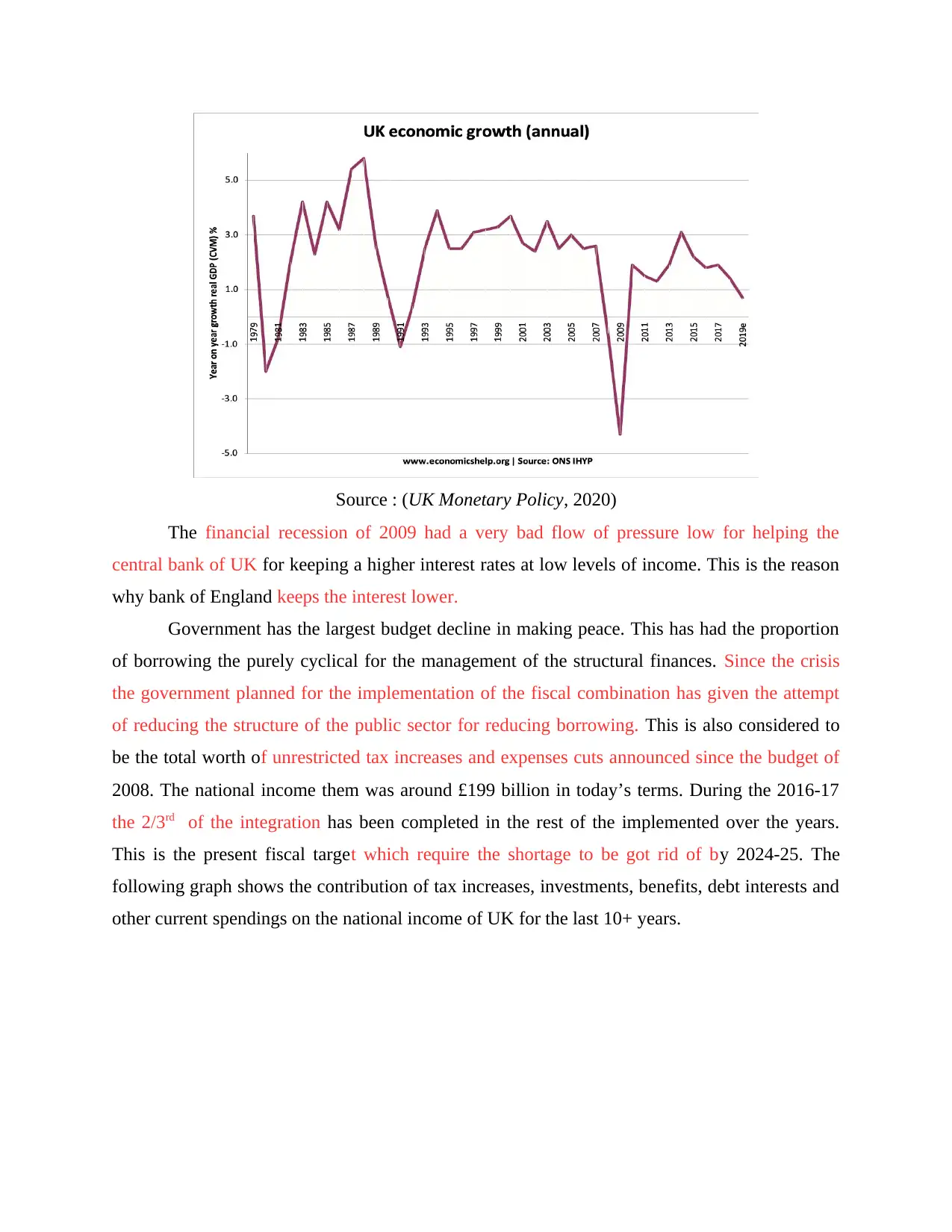
Source : (UK Monetary Policy, 2020)
The financial recession of 2009 had a very bad flow of pressure low for helping the
central bank of UK for keeping a higher interest rates at low levels of income. This is the reason
why bank of England keeps the interest lower.
Government has the largest budget decline in making peace. This has had the proportion
of borrowing the purely cyclical for the management of the structural finances. Since the crisis
the government planned for the implementation of the fiscal combination has given the attempt
of reducing the structure of the public sector for reducing borrowing. This is also considered to
be the total worth of unrestricted tax increases and expenses cuts announced since the budget of
2008. The national income them was around £199 billion in today’s terms. During the 2016-17
the 2/3rd of the integration has been completed in the rest of the implemented over the years.
This is the present fiscal target which require the shortage to be got rid of by 2024-25. The
following graph shows the contribution of tax increases, investments, benefits, debt interests and
other current spendings on the national income of UK for the last 10+ years.
The financial recession of 2009 had a very bad flow of pressure low for helping the
central bank of UK for keeping a higher interest rates at low levels of income. This is the reason
why bank of England keeps the interest lower.
Government has the largest budget decline in making peace. This has had the proportion
of borrowing the purely cyclical for the management of the structural finances. Since the crisis
the government planned for the implementation of the fiscal combination has given the attempt
of reducing the structure of the public sector for reducing borrowing. This is also considered to
be the total worth of unrestricted tax increases and expenses cuts announced since the budget of
2008. The national income them was around £199 billion in today’s terms. During the 2016-17
the 2/3rd of the integration has been completed in the rest of the implemented over the years.
This is the present fiscal target which require the shortage to be got rid of by 2024-25. The
following graph shows the contribution of tax increases, investments, benefits, debt interests and
other current spendings on the national income of UK for the last 10+ years.
Paraphrase This Document
Need a fresh take? Get an instant paraphrase of this document with our AI Paraphraser
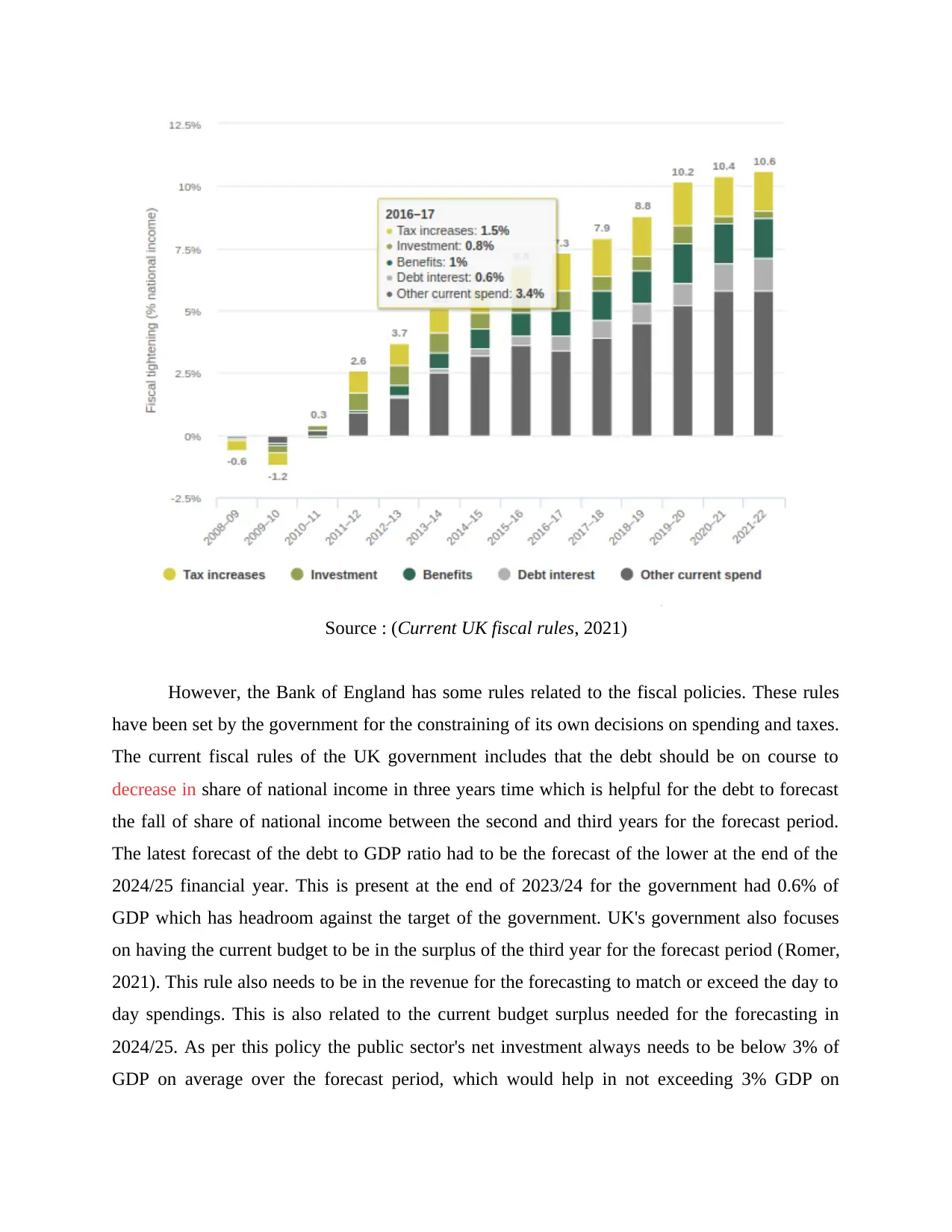
Source : (Current UK fiscal rules, 2021)
However, the Bank of England has some rules related to the fiscal policies. These rules
have been set by the government for the constraining of its own decisions on spending and taxes.
The current fiscal rules of the UK government includes that the debt should be on course to
decrease in share of national income in three years time which is helpful for the debt to forecast
the fall of share of national income between the second and third years for the forecast period.
The latest forecast of the debt to GDP ratio had to be the forecast of the lower at the end of the
2024/25 financial year. This is present at the end of 2023/24 for the government had 0.6% of
GDP which has headroom against the target of the government. UK's government also focuses
on having the current budget to be in the surplus of the third year for the forecast period (Romer,
2021). This rule also needs to be in the revenue for the forecasting to match or exceed the day to
day spendings. This is also related to the current budget surplus needed for the forecasting in
2024/25. As per this policy the public sector's net investment always needs to be below 3% of
GDP on average over the forecast period, which would help in not exceeding 3% GDP on
However, the Bank of England has some rules related to the fiscal policies. These rules
have been set by the government for the constraining of its own decisions on spending and taxes.
The current fiscal rules of the UK government includes that the debt should be on course to
decrease in share of national income in three years time which is helpful for the debt to forecast
the fall of share of national income between the second and third years for the forecast period.
The latest forecast of the debt to GDP ratio had to be the forecast of the lower at the end of the
2024/25 financial year. This is present at the end of 2023/24 for the government had 0.6% of
GDP which has headroom against the target of the government. UK's government also focuses
on having the current budget to be in the surplus of the third year for the forecast period (Romer,
2021). This rule also needs to be in the revenue for the forecasting to match or exceed the day to
day spendings. This is also related to the current budget surplus needed for the forecasting in
2024/25. As per this policy the public sector's net investment always needs to be below 3% of
GDP on average over the forecast period, which would help in not exceeding 3% GDP on
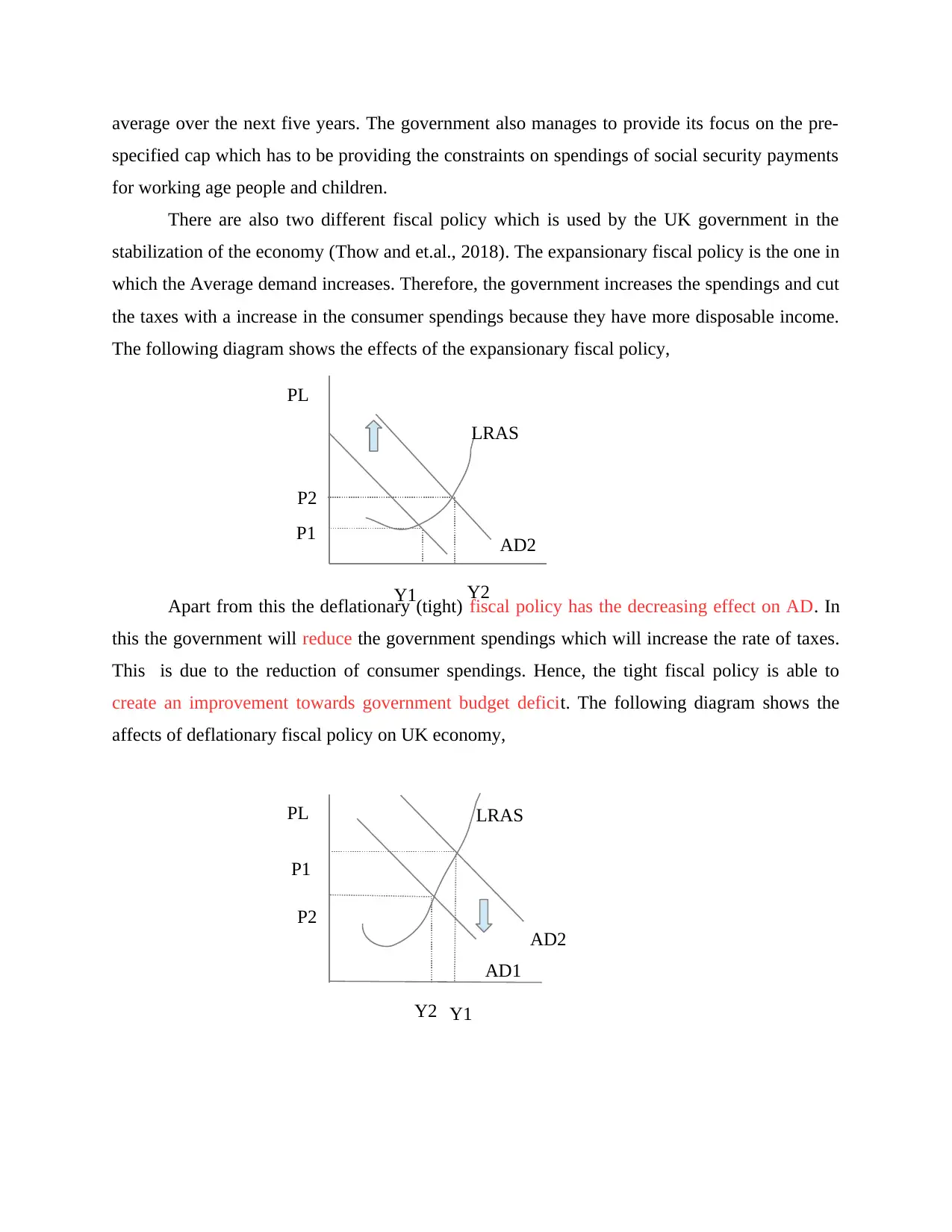
average over the next five years. The government also manages to provide its focus on the pre-
specified cap which has to be providing the constraints on spendings of social security payments
for working age people and children.
There are also two different fiscal policy which is used by the UK government in the
stabilization of the economy (Thow and et.al., 2018). The expansionary fiscal policy is the one in
which the Average demand increases. Therefore, the government increases the spendings and cut
the taxes with a increase in the consumer spendings because they have more disposable income.
The following diagram shows the effects of the expansionary fiscal policy,
Apart from this the deflationary (tight) fiscal policy has the decreasing effect on AD. In
this the government will reduce the government spendings which will increase the rate of taxes.
This is due to the reduction of consumer spendings. Hence, the tight fiscal policy is able to
create an improvement towards government budget deficit. The following diagram shows the
affects of deflationary fiscal policy on UK economy,
LRAS
PL
P2
P1 AD2
Y1 Y2
LRASPL
P2
P1
AD2
AD1
Y2 Y1
specified cap which has to be providing the constraints on spendings of social security payments
for working age people and children.
There are also two different fiscal policy which is used by the UK government in the
stabilization of the economy (Thow and et.al., 2018). The expansionary fiscal policy is the one in
which the Average demand increases. Therefore, the government increases the spendings and cut
the taxes with a increase in the consumer spendings because they have more disposable income.
The following diagram shows the effects of the expansionary fiscal policy,
Apart from this the deflationary (tight) fiscal policy has the decreasing effect on AD. In
this the government will reduce the government spendings which will increase the rate of taxes.
This is due to the reduction of consumer spendings. Hence, the tight fiscal policy is able to
create an improvement towards government budget deficit. The following diagram shows the
affects of deflationary fiscal policy on UK economy,
LRAS
PL
P2
P1 AD2
Y1 Y2
LRASPL
P2
P1
AD2
AD1
Y2 Y1
⊘ This is a preview!⊘
Do you want full access?
Subscribe today to unlock all pages.

Trusted by 1+ million students worldwide
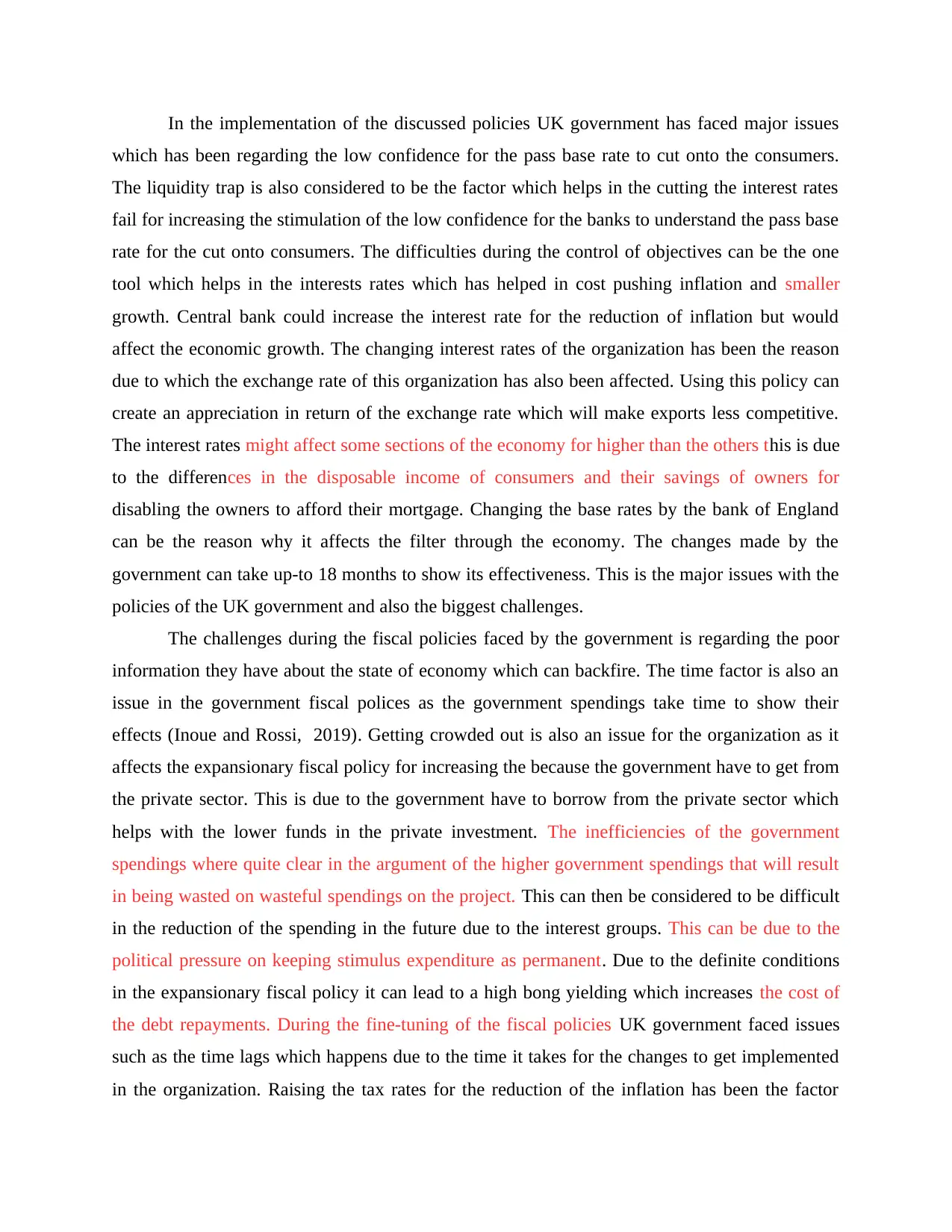
In the implementation of the discussed policies UK government has faced major issues
which has been regarding the low confidence for the pass base rate to cut onto the consumers.
The liquidity trap is also considered to be the factor which helps in the cutting the interest rates
fail for increasing the stimulation of the low confidence for the banks to understand the pass base
rate for the cut onto consumers. The difficulties during the control of objectives can be the one
tool which helps in the interests rates which has helped in cost pushing inflation and smaller
growth. Central bank could increase the interest rate for the reduction of inflation but would
affect the economic growth. The changing interest rates of the organization has been the reason
due to which the exchange rate of this organization has also been affected. Using this policy can
create an appreciation in return of the exchange rate which will make exports less competitive.
The interest rates might affect some sections of the economy for higher than the others this is due
to the differences in the disposable income of consumers and their savings of owners for
disabling the owners to afford their mortgage. Changing the base rates by the bank of England
can be the reason why it affects the filter through the economy. The changes made by the
government can take up-to 18 months to show its effectiveness. This is the major issues with the
policies of the UK government and also the biggest challenges.
The challenges during the fiscal policies faced by the government is regarding the poor
information they have about the state of economy which can backfire. The time factor is also an
issue in the government fiscal polices as the government spendings take time to show their
effects (Inoue and Rossi, 2019). Getting crowded out is also an issue for the organization as it
affects the expansionary fiscal policy for increasing the because the government have to get from
the private sector. This is due to the government have to borrow from the private sector which
helps with the lower funds in the private investment. The inefficiencies of the government
spendings where quite clear in the argument of the higher government spendings that will result
in being wasted on wasteful spendings on the project. This can then be considered to be difficult
in the reduction of the spending in the future due to the interest groups. This can be due to the
political pressure on keeping stimulus expenditure as permanent. Due to the definite conditions
in the expansionary fiscal policy it can lead to a high bong yielding which increases the cost of
the debt repayments. During the fine-tuning of the fiscal policies UK government faced issues
such as the time lags which happens due to the time it takes for the changes to get implemented
in the organization. Raising the tax rates for the reduction of the inflation has been the factor
which has been regarding the low confidence for the pass base rate to cut onto the consumers.
The liquidity trap is also considered to be the factor which helps in the cutting the interest rates
fail for increasing the stimulation of the low confidence for the banks to understand the pass base
rate for the cut onto consumers. The difficulties during the control of objectives can be the one
tool which helps in the interests rates which has helped in cost pushing inflation and smaller
growth. Central bank could increase the interest rate for the reduction of inflation but would
affect the economic growth. The changing interest rates of the organization has been the reason
due to which the exchange rate of this organization has also been affected. Using this policy can
create an appreciation in return of the exchange rate which will make exports less competitive.
The interest rates might affect some sections of the economy for higher than the others this is due
to the differences in the disposable income of consumers and their savings of owners for
disabling the owners to afford their mortgage. Changing the base rates by the bank of England
can be the reason why it affects the filter through the economy. The changes made by the
government can take up-to 18 months to show its effectiveness. This is the major issues with the
policies of the UK government and also the biggest challenges.
The challenges during the fiscal policies faced by the government is regarding the poor
information they have about the state of economy which can backfire. The time factor is also an
issue in the government fiscal polices as the government spendings take time to show their
effects (Inoue and Rossi, 2019). Getting crowded out is also an issue for the organization as it
affects the expansionary fiscal policy for increasing the because the government have to get from
the private sector. This is due to the government have to borrow from the private sector which
helps with the lower funds in the private investment. The inefficiencies of the government
spendings where quite clear in the argument of the higher government spendings that will result
in being wasted on wasteful spendings on the project. This can then be considered to be difficult
in the reduction of the spending in the future due to the interest groups. This can be due to the
political pressure on keeping stimulus expenditure as permanent. Due to the definite conditions
in the expansionary fiscal policy it can lead to a high bong yielding which increases the cost of
the debt repayments. During the fine-tuning of the fiscal policies UK government faced issues
such as the time lags which happens due to the time it takes for the changes to get implemented
in the organization. Raising the tax rates for the reduction of the inflation has been the factor
Paraphrase This Document
Need a fresh take? Get an instant paraphrase of this document with our AI Paraphraser
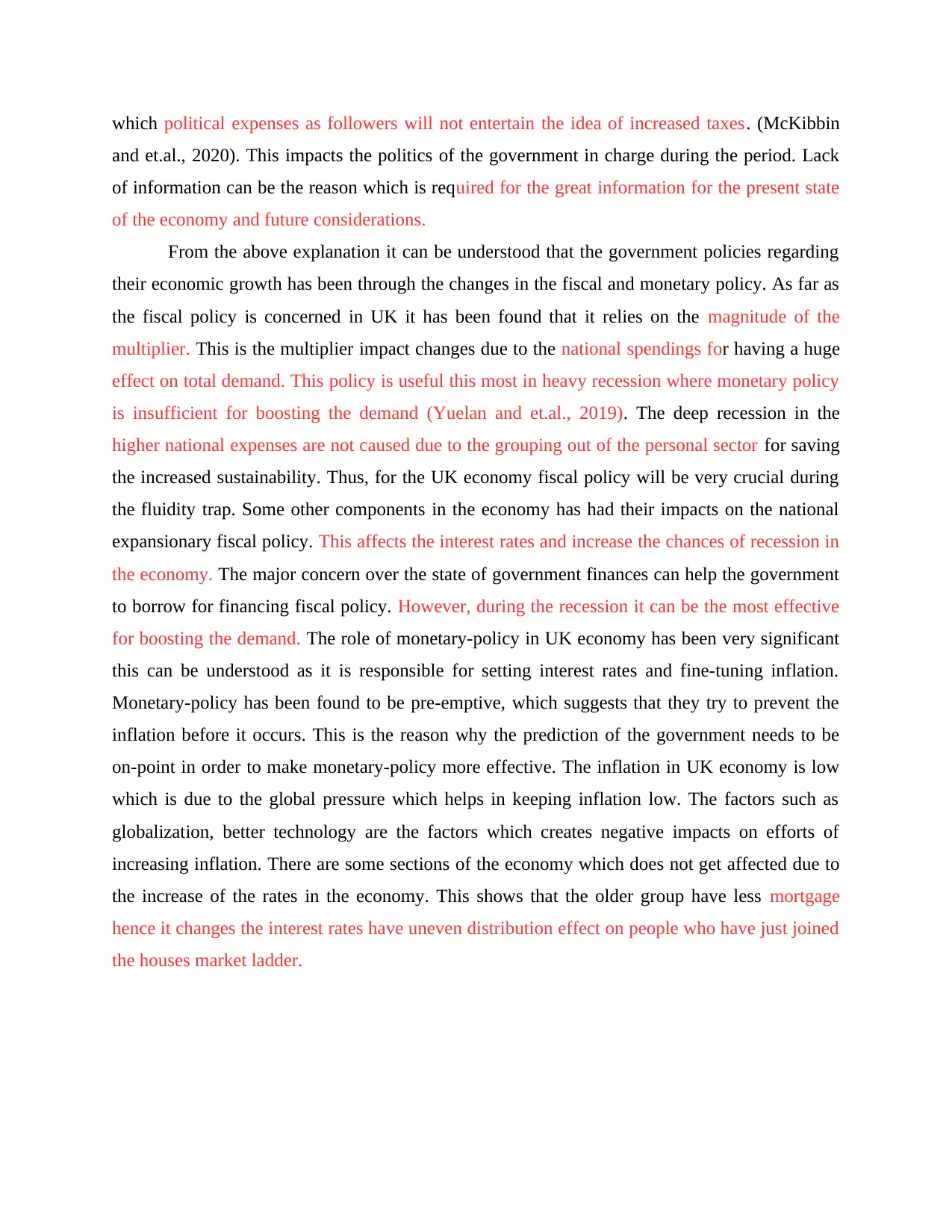
which political expenses as followers will not entertain the idea of increased taxes. (McKibbin
and et.al., 2020). This impacts the politics of the government in charge during the period. Lack
of information can be the reason which is required for the great information for the present state
of the economy and future considerations.
From the above explanation it can be understood that the government policies regarding
their economic growth has been through the changes in the fiscal and monetary policy. As far as
the fiscal policy is concerned in UK it has been found that it relies on the magnitude of the
multiplier. This is the multiplier impact changes due to the national spendings for having a huge
effect on total demand. This policy is useful this most in heavy recession where monetary policy
is insufficient for boosting the demand (Yuelan and et.al., 2019). The deep recession in the
higher national expenses are not caused due to the grouping out of the personal sector for saving
the increased sustainability. Thus, for the UK economy fiscal policy will be very crucial during
the fluidity trap. Some other components in the economy has had their impacts on the national
expansionary fiscal policy. This affects the interest rates and increase the chances of recession in
the economy. The major concern over the state of government finances can help the government
to borrow for financing fiscal policy. However, during the recession it can be the most effective
for boosting the demand. The role of monetary-policy in UK economy has been very significant
this can be understood as it is responsible for setting interest rates and fine-tuning inflation.
Monetary-policy has been found to be pre-emptive, which suggests that they try to prevent the
inflation before it occurs. This is the reason why the prediction of the government needs to be
on-point in order to make monetary-policy more effective. The inflation in UK economy is low
which is due to the global pressure which helps in keeping inflation low. The factors such as
globalization, better technology are the factors which creates negative impacts on efforts of
increasing inflation. There are some sections of the economy which does not get affected due to
the increase of the rates in the economy. This shows that the older group have less mortgage
hence it changes the interest rates have uneven distribution effect on people who have just joined
the houses market ladder.
and et.al., 2020). This impacts the politics of the government in charge during the period. Lack
of information can be the reason which is required for the great information for the present state
of the economy and future considerations.
From the above explanation it can be understood that the government policies regarding
their economic growth has been through the changes in the fiscal and monetary policy. As far as
the fiscal policy is concerned in UK it has been found that it relies on the magnitude of the
multiplier. This is the multiplier impact changes due to the national spendings for having a huge
effect on total demand. This policy is useful this most in heavy recession where monetary policy
is insufficient for boosting the demand (Yuelan and et.al., 2019). The deep recession in the
higher national expenses are not caused due to the grouping out of the personal sector for saving
the increased sustainability. Thus, for the UK economy fiscal policy will be very crucial during
the fluidity trap. Some other components in the economy has had their impacts on the national
expansionary fiscal policy. This affects the interest rates and increase the chances of recession in
the economy. The major concern over the state of government finances can help the government
to borrow for financing fiscal policy. However, during the recession it can be the most effective
for boosting the demand. The role of monetary-policy in UK economy has been very significant
this can be understood as it is responsible for setting interest rates and fine-tuning inflation.
Monetary-policy has been found to be pre-emptive, which suggests that they try to prevent the
inflation before it occurs. This is the reason why the prediction of the government needs to be
on-point in order to make monetary-policy more effective. The inflation in UK economy is low
which is due to the global pressure which helps in keeping inflation low. The factors such as
globalization, better technology are the factors which creates negative impacts on efforts of
increasing inflation. There are some sections of the economy which does not get affected due to
the increase of the rates in the economy. This shows that the older group have less mortgage
hence it changes the interest rates have uneven distribution effect on people who have just joined
the houses market ladder.
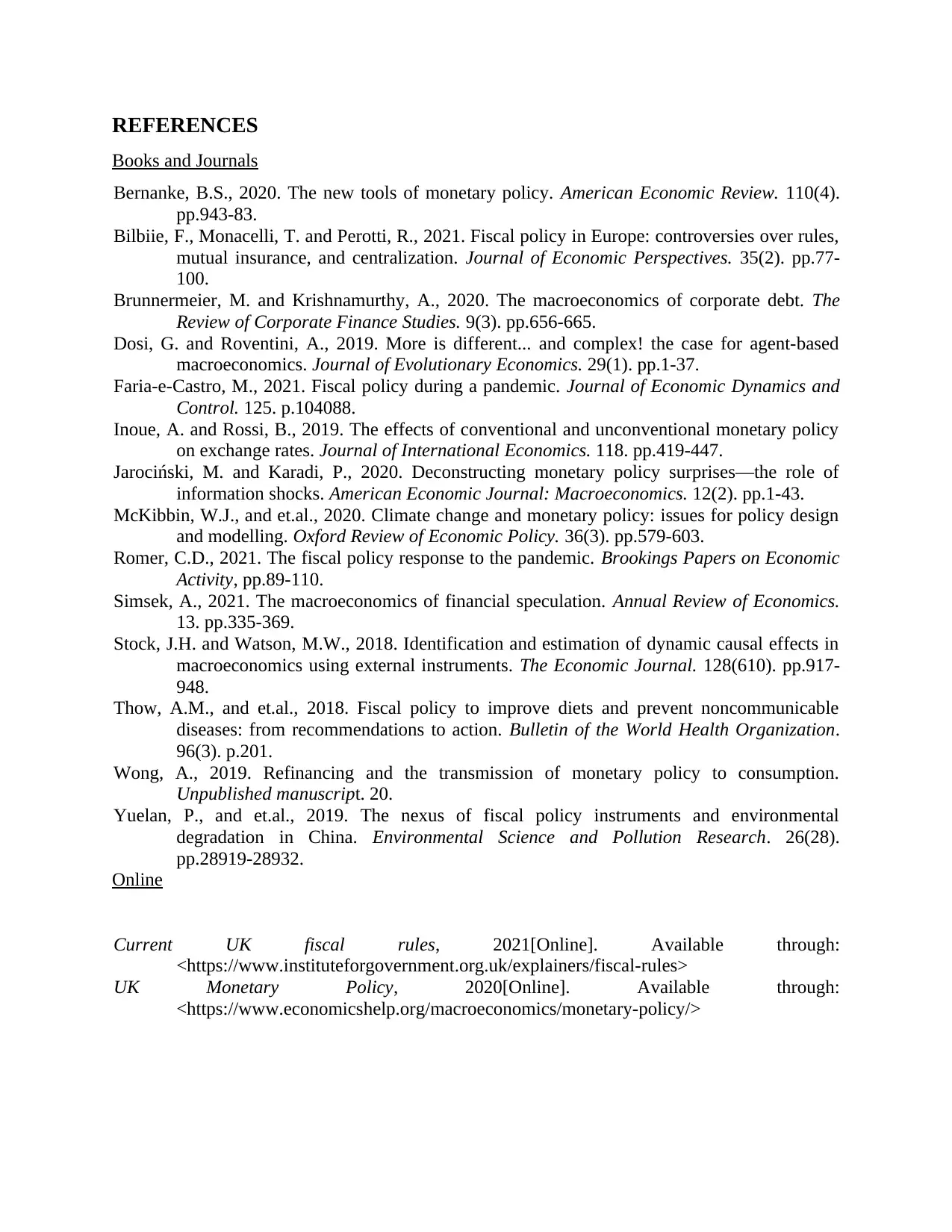
REFERENCES
Books and Journals
Bernanke, B.S., 2020. The new tools of monetary policy. American Economic Review. 110(4).
pp.943-83.
Bilbiie, F., Monacelli, T. and Perotti, R., 2021. Fiscal policy in Europe: controversies over rules,
mutual insurance, and centralization. Journal of Economic Perspectives. 35(2). pp.77-
100.
Brunnermeier, M. and Krishnamurthy, A., 2020. The macroeconomics of corporate debt. The
Review of Corporate Finance Studies. 9(3). pp.656-665.
Dosi, G. and Roventini, A., 2019. More is different... and complex! the case for agent-based
macroeconomics. Journal of Evolutionary Economics. 29(1). pp.1-37.
Faria-e-Castro, M., 2021. Fiscal policy during a pandemic. Journal of Economic Dynamics and
Control. 125. p.104088.
Inoue, A. and Rossi, B., 2019. The effects of conventional and unconventional monetary policy
on exchange rates. Journal of International Economics. 118. pp.419-447.
Jarociński, M. and Karadi, P., 2020. Deconstructing monetary policy surprises—the role of
information shocks. American Economic Journal: Macroeconomics. 12(2). pp.1-43.
McKibbin, W.J., and et.al., 2020. Climate change and monetary policy: issues for policy design
and modelling. Oxford Review of Economic Policy. 36(3). pp.579-603.
Romer, C.D., 2021. The fiscal policy response to the pandemic. Brookings Papers on Economic
Activity, pp.89-110.
Simsek, A., 2021. The macroeconomics of financial speculation. Annual Review of Economics.
13. pp.335-369.
Stock, J.H. and Watson, M.W., 2018. Identification and estimation of dynamic causal effects in
macroeconomics using external instruments. The Economic Journal. 128(610). pp.917-
948.
Thow, A.M., and et.al., 2018. Fiscal policy to improve diets and prevent noncommunicable
diseases: from recommendations to action. Bulletin of the World Health Organization.
96(3). p.201.
Wong, A., 2019. Refinancing and the transmission of monetary policy to consumption.
Unpublished manuscript. 20.
Yuelan, P., and et.al., 2019. The nexus of fiscal policy instruments and environmental
degradation in China. Environmental Science and Pollution Research. 26(28).
pp.28919-28932.
Online
Current UK fiscal rules, 2021[Online]. Available through:
<https://www.instituteforgovernment.org.uk/explainers/fiscal-rules>
UK Monetary Policy, 2020[Online]. Available through:
<https://www.economicshelp.org/macroeconomics/monetary-policy/>
Books and Journals
Bernanke, B.S., 2020. The new tools of monetary policy. American Economic Review. 110(4).
pp.943-83.
Bilbiie, F., Monacelli, T. and Perotti, R., 2021. Fiscal policy in Europe: controversies over rules,
mutual insurance, and centralization. Journal of Economic Perspectives. 35(2). pp.77-
100.
Brunnermeier, M. and Krishnamurthy, A., 2020. The macroeconomics of corporate debt. The
Review of Corporate Finance Studies. 9(3). pp.656-665.
Dosi, G. and Roventini, A., 2019. More is different... and complex! the case for agent-based
macroeconomics. Journal of Evolutionary Economics. 29(1). pp.1-37.
Faria-e-Castro, M., 2021. Fiscal policy during a pandemic. Journal of Economic Dynamics and
Control. 125. p.104088.
Inoue, A. and Rossi, B., 2019. The effects of conventional and unconventional monetary policy
on exchange rates. Journal of International Economics. 118. pp.419-447.
Jarociński, M. and Karadi, P., 2020. Deconstructing monetary policy surprises—the role of
information shocks. American Economic Journal: Macroeconomics. 12(2). pp.1-43.
McKibbin, W.J., and et.al., 2020. Climate change and monetary policy: issues for policy design
and modelling. Oxford Review of Economic Policy. 36(3). pp.579-603.
Romer, C.D., 2021. The fiscal policy response to the pandemic. Brookings Papers on Economic
Activity, pp.89-110.
Simsek, A., 2021. The macroeconomics of financial speculation. Annual Review of Economics.
13. pp.335-369.
Stock, J.H. and Watson, M.W., 2018. Identification and estimation of dynamic causal effects in
macroeconomics using external instruments. The Economic Journal. 128(610). pp.917-
948.
Thow, A.M., and et.al., 2018. Fiscal policy to improve diets and prevent noncommunicable
diseases: from recommendations to action. Bulletin of the World Health Organization.
96(3). p.201.
Wong, A., 2019. Refinancing and the transmission of monetary policy to consumption.
Unpublished manuscript. 20.
Yuelan, P., and et.al., 2019. The nexus of fiscal policy instruments and environmental
degradation in China. Environmental Science and Pollution Research. 26(28).
pp.28919-28932.
Online
Current UK fiscal rules, 2021[Online]. Available through:
<https://www.instituteforgovernment.org.uk/explainers/fiscal-rules>
UK Monetary Policy, 2020[Online]. Available through:
<https://www.economicshelp.org/macroeconomics/monetary-policy/>
⊘ This is a preview!⊘
Do you want full access?
Subscribe today to unlock all pages.

Trusted by 1+ million students worldwide
1 out of 13
Related Documents
Your All-in-One AI-Powered Toolkit for Academic Success.
+13062052269
info@desklib.com
Available 24*7 on WhatsApp / Email
![[object Object]](/_next/static/media/star-bottom.7253800d.svg)
Unlock your academic potential
Copyright © 2020–2025 A2Z Services. All Rights Reserved. Developed and managed by ZUCOL.





